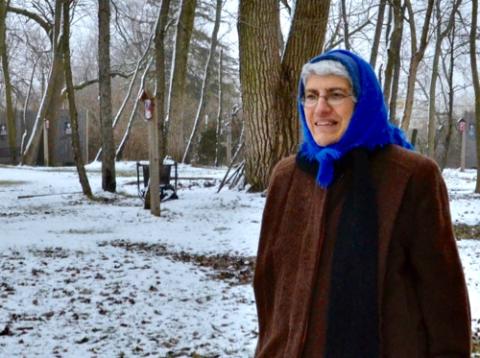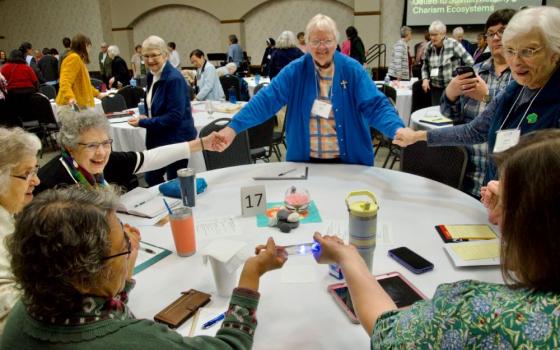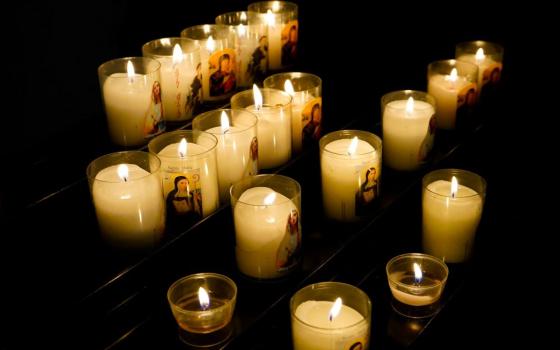
Dwelling Place Sr. Clare Van Lent shows the grounds of the community's retreat center in Brooksville, Mississippi, in September 2019. Behind her is Sr. Mary Horrell. The Dwelling Place is a private association of the faithful featured in the 2017 edition of "Emerging U.S. Communities of Consecrated Life Since Vatican II." (GSR photo / Dan Stockman)
Editor's note: This story is part of a four-part series on religious communities that have been created since 1965, the year the Second Vatican Council ended. The emerging communities come from the third edition of a 2017 directory, "Emerging U.S. Communities of Consecrated Life Since Vatican II." This part explores three private associations of the faithful. Read the rest of the series here.
The only sign there is anything unusual about the little yellow house with a white picket fence is the box for outgoing mail: Instead of a mailbox, it's a large plastic tote the mail carrier can wheel to the truck to empty.
The volume of outgoing mail — packages being shipped from an online store run out of the house — is one of the few exterior signs of the Confraternity of Penitents, a group of laypeople who shun most outward signs of their religious life, as St. Francis' Rule of 1221 proscribes.
The Confraternity of Penitents allows laypeople to live religious life without entering a religious order or giving up careers, marriage and children. It is one of 159 communities included in the 2017 directory of emerging communities published by the Center for Applied Research in the Apostolate at Georgetown University. The directory lists religious communities formed in the United States since the Second Vatican Council.

Madeline Pecora Nugent in Mary's Glen, a prayer park at the Confraternity of Penitents, a private association of the faithful, on Jan. 27 in Fort Wayne, Indiana. Nugent is the minister general of the Penitents. (GSR photo / Dan Stockman)
Minister General Madeline Pecora Nugent said St. Francis designed the Rule of 1221 to be a way for laypeople to draw closer to God without having to enter formal religious life.
"We felt called to live as close as possible to the rule as is possible now," she said. Members dress and live simply, pray the Liturgy of the Hours daily, fast and abstain from meat weekly.
However, "you can't follow it precisely today — you would look weird," she said. The original rule decrees adherents may only wear wool tunics costing less than $5.
Penitents can be women or men, single or married, lay or consecrated. The group is a private association of the faithful, a group formed by laypeople with the blessing of the local bishop and recognized by the Catholic Church.
"People are looking for something," Nugent said. "They want a deeper relationship with God, and they see this as a means to do that. ... It gives you a very detailed way to do that, plus it gives you the support of other people. And it's meant for laypeople."
In 1998, Nugent and five others received the approval of their local bishop, Robert Mulvee of Providence, Rhode Island, where the members all lived. The six became an official private association of the faithful.
In 2013, the group moved to Fort Wayne, where they knew a Franciscan priest. The priest knew a home on the city's east side that had been donated to the diocese and he asked Bishop Kevin Rhoades of Fort Wayne-South Bend to consider letting the Confraternity use it. Rhoades blessed the property in November of that year.

A volunteer works in the office of the Confraternity of Penitents in Fort Wayne, Indiana, a private association of the faithful featured in the 2017 edition of "Emerging U.S. Communities of Consecrated Life Since Vatican II." (GSR photo / Dan Stockman)
On a cold winter's day, the house is warm with volunteers working in the office and kitchen. In addition to being the group's office and meeting space, the house is also home to the Nugent family; Madeline Nugent's husband, Jim Nugent, is also a Penitent.
"We felt called to live the original rule, and there wasn't anyone else doing it at the time we started that we knew of," Madeline Nugent said. "It's a way to live a spiritual life in your own home. It's designed for secular living."
Vice Minister Sandy Seyfert said she wanted to live a life where God is at the center but didn't know how to do that until she found the Confraternity.
"I was looking for something, but I didn't know what," Seyfert said. "It's a way to deepen my faith life."
Today, there are 133 members, 30 associates who complete formation but do not pledge to follow the rule as members do, and 71 affiliates who pray with the group. There are also 110 inquirers, those in the first stage of formation. Some members are part of the Penitents' many ministries, including its online bookstore, or have their own. Others are part of their parish or diocesan ministries.
Member Jackie Stevens, who pledged to live the rule on Oct. 12, 2019, said the life gives discipline and structure to her day, allowing her to balance family, work and spiritual life.
"It grounds me," Stevens said. "It helps me to grow and continue to form my interior life in a spiritual way."

Jackie Stevens, left, and Sandy Seyfert pet the cat in the storage area for the online store operated by the Confraternity of Penitents, a private association of the faithful, on Jan. 27 in Fort Wayne, Indiana. (GSR photo / Dan Stockman)
'People who say yes'
Sr. Clare Van Lent was called to help form interior lives through spiritual retreats.
Van Lent was a Franciscan sister in Dubuque, Iowa, on retreat in Wisconsin in 1985 when she heard the words, "Minister to my ministers."
When she asked where, the answer was Mississippi, a place Van Lent knew nothing about. She was told to "call it the Dwelling Place."
"God doesn't need super-apostles," Van Lent said. "He needs people who say yes."
So Van Lent said yes.
In 1987, Van Lent and another Dubuque Franciscan, Sr. Margaret Kosse, went to Mississippi.
"We didn't know a soul," Van Lent said.
But they connected with a mission parish in Macon, 125 miles northeast of Jackson, and soon heard of a group of Trappist monks selling land in nearby Brooksville. The monks sold most of the land but gave 17 acres to the sisters, and the Dwelling Place had a home. By the early 1990s, they had built a guesthouse and three hermitages and began hosting retreats.

One of the hermitages that sit in the shade of pecan trees at the Dwelling Place retreat center in Brooksville, Mississippi. The Dwelling Place is a private association of the faithful featured in the 2017 edition of "Emerging U.S. Communities of Consecrated Life Since Vatican II." (GSR photo / Dan Stockman)
By 1997, Van Lent said, "I had an itch inside me that said, 'Leave the Franciscans.' ... Quite a few people were interested [in forming a new community], and I said, 'If God doesn't want me hooked to the Franciscans, this thing must stand alone.' "
Van Lent formed a lay community, and by 2000, the Dwelling Place was made a private association of the faithful.
At its peak in the late 2000s, the Dwelling Place had 25 members, Van Lent said, but many were reluctant to take vows.
"People didn't know whether they wanted to be part of it or not," said Sr. Mary Horrell. "They liked what they were doing as associates."
Horrell, also a former Dubuque Franciscan, moved to Brooksville in 1996. She joined the new community when it was formed in 2000.

Sr. Clare Van Lent, left, and Sr. Mary Horrell look at the grounds of the retreat center run by their order, the Dwelling Place, in September 2019 in Brooksville, Mississippi. The Dwelling Place is a private association of the faithful; Van Lent and Horrell are the last remaining members. (GSR photo / Dan Stockman)
Kosse died suddenly and unexpectedly just a few months before the Dwelling Place was made a private association of the faithful, and today, only Van Lent, Horrell and about a dozen associates remain.
But the Dwelling Place retreat center continues, hosting about 300 retreats a year in its four-bedroom guesthouse or three individual hermitages, all in the 17-acre grove of towering pines and spreading pecan trees, which offer shade from the sweltering Mississippi sun. Dogs Luke Skywalker and Yoda are constant companions.
Van Lent, 85, and Horrell, 67, know they won't live forever. But they know it's in God's hands.

Sr. Clare Van Lent gives a tour of one of the Dwelling Place's retreat houses in Brooksville, Mississippi, while dogs Luke Skywalker and Yoda check things out. (GSR photo / Dan Stockman)
"Everything here is a gift," Van Lent said. Retreat fees cover operating costs, but the capital costs for buildings and equipment have all been donated. When there has been a need, she said, God has provided.
"We've been here 32 years now. Who would have thought it would last this long?" Van Lent said. "And God tells us it's going to continue. ... I was praying the other day, and I heard the words, 'I will send someone.' "
'For women like me'
Sr. Lillanna Kopp heard the call of Vatican II renewal.
Kopp had been a member of the Sisters of the Holy Names of Jesus and Mary, but like many other sisters after 1965, she felt called to leave the structures of religious life but not religious life itself. The question was how to do that.
In 1970, Kopp wrote an article for an intercongregational newsletter on renewal that, in broad strokes, described how a religious community might form a network of communication and unity that transcended geographical distances. Just months later, the Sisters for Christian Community was born, almost entirely made up of sisters from other communities.
The sisters do not own property in common, a motherhouse or any other communal institution and are organized by geographic locations: There are 21 regions in the United States, two nongeographic "virtual" regions and 19 other regions around the world.
Advertisement
Members meet within their regions and at an annual international assembly. This year's assembly will celebrate the community's golden jubilee July 12-17 in Kansas City, Missouri.
Sr. Rita Yeasted, the international communication coordinator, said she didn't completely understand Kopp's vision when she first heard it.
"She wanted to found a community for women like me who were out of their communities but were still attracted to religious life," Yeasted said. "It's a very prophetic, ecclesial community."
Yeasted was a Sister of Divine Providence for 25 years but joined the Sisters for Christian Community in 1987.
While the community has always been international, Yeasted said it will be less and less U.S.-centric in the future: Of the 42 women in formation, 40 are from outside the United States. There are 334 professed sisters, 255 of whom are in the United States.
The distributed structure of the community makes it easier not only for women outside the United States to join using online formation and mentorship through Skype, but for women who want to stay in their careers, as well.
"Usually, women have to leave their profession to go into the novitiate, which is not easy to do," especially since they are still discerning, Yeasted said. "In our community, that's not a difficulty."
The community is not unlike the medieval Beguines, who usually did not live in community but wanted to be consecrated, Yeasted said.
"We have that same spirit: We read the Word of God, and we want to take it out into the world," she said. "One of the things I've always cherished about being a religious woman is living out Vatican II."
Source: "Emerging U.S. Communities of Consecrated Life Since Vatican II," Center for Applied Research in the Apostolate at Georgetown University (GSR graphic / Pam Hackenmiller)
[Dan Stockman is national correspondent for Global Sisters Report. His email address is dstockman@ncronline.org. Follow him on Twitter or on Facebook.]









